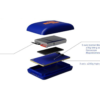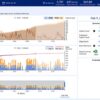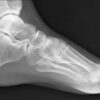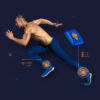Don’t want to search through the FAQs for an answer? No problem.
Just tweet at us on Twitter, or drop our support team a line.
IMU Step FAQs
How many sensors do I need for IMU-Step?
We highly recommend 2 sensors to gain a better understanding of the load on each limb and associated asymmetry.
Where do you put the sensor?
The lower medial side of the tibia, just above the malleolus (i.e. just above the ankle bone on the inner side of the leg). This location is the best surrogate measure of tibial shock. Tibial shock is the only biomechanical variable proven to be associated with lower limb fatigue fractures.
What is 'Step Intensity'?
Step intensity is a measure of the tibial shock propagated into the leg during walking or running. We calculate this by taking the peak resultant acceleration caused by the impact of each step. Peak resultant acceleration is calculated from the sensor X, Y and Z axes acceleration values.
What is 'Bone Load'?
The “Accumulative Bone Load” or “Bone Load” metric is a scientific based model of loads accumulated in the lower limbs. These loads occur from impacts created when the foot strikes the ground at every step taken.
The IMU sensor measures each impact created from every step taken, and IMU Step calculates the Bone Load value based on all the recorded impacts. Bone Load is dependent on:
1) The total number of steps taken
2) The size of the impact derived from each individual step.
If there is a large number of total steps, the Bone Load will also be large.
Given the same number of steps, if there is a larger proportion of “High Intensity” steps (heavy steps that experience a larger impact), the Bone Load value will be larger than the previous value. This is because Bone Load is dependent on the total number of steps as well as the size of the impact from each individual step.
Bone Load is more responsive to the size of step impact rather than the number of steps taken. Therefore a “High Intensity” impact may contribute more to the “Accumulative Bone Load” value than several “Low Intensity” impacts.
What is the best use case for IMU Step?
IMU Step was designed to measure & manage lower limb load in running based sports e.g. running, basketball, soccer. It is particularly useful for lower limb injuries since you can precisely measure and therefore manage lower limb load for both legs. It is also useful for indoor running sports such as basketball, volleyball and netball since it quantifies every step taken & does not require a connection to a satellite.
What is Asymmetry?
Asymmetry is a comparison of the step intensities between the right and left legs. A difference in the number of steps and/or the intensity of steps taken will result in an asymmetry of load between the left and right legs. This can be used to monitor a potentially injured athlete who has an injury on one leg, or to monitor an athlete to make sure they aren’t displaying any abnormal loading asymmetries that may lead to injury.
How can you measure up to 27g if the sensors maximum gs are 16g?
When we measure each step intensity we are calculating the resultant acceleration which take into account the X, Y & Z axes of the sensor, not just the vertical axis.
Why do the sensors measure at such high frequency?
Research shows that to precisely identify & characterise human step impacts you need to be able to measure each step at over 400Hz. Step impacts are fast transient loads, so it is important to measure these loads with a high sampling frequency in order to characterise them.
General FAQs
How are the X, Y and Z axes orientated on the sensor?
The sensor axes orientation can be found in the sensor spec sheet here.
How do I attach the sensors to the body?
We provide sensor straps for attaching sensors to the upper and lower limbs. Our sensors can also be strapped to the body using physiotherapy strapping tape, and can still maintain a wireless connection when taped within an athlete’s strapping. Send us an inquiry if you would like to learn more about our strap solutions.
How do I position the sensors when attaching them to the body?
Best practise for sensor placement is what we call the “man-up” position.
– The black half of the sensor is closest to the body, with orange facing out
– The IMU Man is standing up, with the on/off switch pointing down
It is useful employing this method as it helps knowing sensor orientation when interpreting your data during analysis
What devices can I use to control my IMU Sensors?
You can use our sensors with any Apple iOS device released since 2014. We recommend you use the latest iOS Software on your device when using our apps. If you are looking to buy an Apple device, we recommend the iPad mini 4.
If you have a Vicon system, you can control your IMU sensors from your machine running Nexus.
My computer doesn't seem to be able to detect my sensors. Now what?
Make sure you have downloaded and installed all the latest required drivers when using Lightning and IMU Step Desktop to download data. If your computer should ever stop detecting sensors, you may need to download and install the updated driver – this could be because of computer operating system updates. If your sensors are still not recognised, unplug your sensors, turn them off and on, then plug them in again. If the problem persists, head to support page page and someone from our team will help you out.
Can I record using multiple sensors from one iOS device?
Yes, you can. We can support up to 8 sensors total per iOS device during certain logging modes. See the IMU Sensor page for more info.
Is my data filtered in any way when I download it?
No. The data you collect is unfiltered and transparent. This allows you to utilise the most appropriate filtering techniques for deriving the metrics you want. Hooray for no black boxes!
Where can I find information about IMU Research?
You can find information about IMU Research here.
Where can I find information about IMU Step?
You can find information about IMU Step here.
Where can I get support for my IMU product?
Head to our support page and send us a message – our support team will reply ASAP!
















